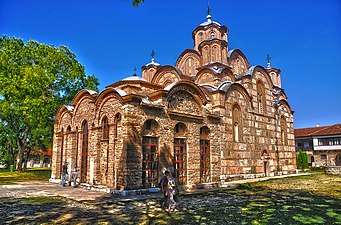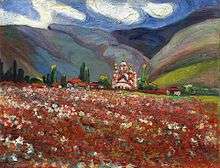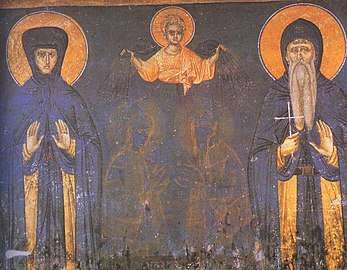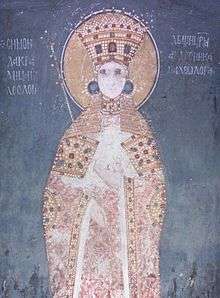Gračanica Monastery
Gračanica Monastery (pronounced [ɡratʃǎnitsa]; Serbian: Манастир Грачаница / Manastir Gračanica, Albanian: Manastiri i Graçanicës) is a Serbian Orthodox monastery located in Kosovo. It was built by the Serbian king Stefan Milutin in 1321 on the ruins of a 6th-century basilica. The monastery was declared a Monument of Culture of Exceptional Importance in 1990, and on 13 July 2006 it was placed on UNESCO's World Heritage List under the name of Medieval Monuments in Kosovo as an extension of the Visoki Dečani site which was overall placed on the List of World Heritage in Danger.
 Gračanica | |
| Monastery information | |
|---|---|
| Other names | Holy Virgin's temple of Gračanica |
| Order | Serbian Orthodox |
| Established | 1321 |
| Dedicated to | Holy Virgin |
| Diocese | Eparchy of Raška and Prizren |
| People | |
| Founder(s) | King Stefan Milutin |
| Important associated figures | Stefan Milutin, Queen Simonida, Patriarch Makarije Sokolović |
| Architecture | |
| Style | Serbo-Byzantine style |
| Site | |
| Location | Village of Gračanica, 5 km (3.1 mi) from Pristina, Kosovo[a] |
| Public access | yes |
| Official name | Medieval Monuments in Kosovo |
| Type | Cultural |
| Criteria | ii, iii, iv |
| Designated | 2004 (28th session) |
| Reference no. | 724-004bis |
| Region | Europe and North America |
| State party | Serbia |
| Extensions | 2006 |
| Official name | МАНАСТИР ГРАЧАНИЦА, |
| Type | Monument of Culture of Exceptional Importance |
| Designated | 1947 |
| Reference no. | СК 1367[1] |
The Gračanica Monastery is one of King Milutin's last monumental endowments. The monastery is located in Gračanica, a Serbian enclave in the close vicinity of Lipljan, the old residence of bishops of Lipljan.
Geography
The monastery is located in Gračanica, a Serbian enclave near Lipljan, some 5 km (3.1 mi) from Pristina. It is situated on the Kosovo field, on the left riverbank of Gračanka, a right tributary of the Sitnica river. The name is derived from Slavic Gradac, a toponym of fortified cities.[2]
History

Gračanica was constructed on the ruins of an older 13th-century church of the Holy Virgin, which itself was built on the ruins of a 6th-century early Christian three-naved basilica. It was located in the centre of the Eparchy of Lipljan. Stefan Milutin's ktetor comment are written on the southern wall, including "I have seen the ruins and the decay of the Holy Virgin's temple of Gračanica, the bishopric of Lipljan, so I have built it from the ground and painted and decorated it both from inside and outside". In 1346, when the Serbian Archbishopric was raised to the rank of Patriarchate, the bishop of Lipljan was granted the honorary title of metropolitan bishop, and since that time they were called metropolitans of Lipljan or Gračanica.
Of the former monastic compound, only the church has survived. The narthex and the tower were added a few decades later, in order to protect the frescoes on the west facade. The narthex was heavily damaged by the Ottomans several times between 1379–1383, when the tower was burned and a fire devoured a rich collection of manuscripts and other precious objects. The narthex was reconstructed in 1383. Again, Gračanica suffered damages at the time of the Battle of Kosovo (1389).
During Ottoman rule Gračanica became an important cultural center. In the time of Metropolitan Nikanor (1528–1555) several icons were painted on the altarpiece. Also, because of the printing press, Nikanor obtained numerous service books and objects for monastic use. The royal doors were commissioned in 1564 by Metropolitan Dionisije, whose death is represented on a fresco in the narthex. Major restoration took place through efforts of Patriarch Makarije Sokolović. All the openings on the external narthex were walled up and new frescoes were completed in 1570. Thanks to Patriarch Pajsije, the church got its leaden roofing, and in 1620 the large cross with crucifix was made on the iconostasis. The monastery was exposed to new damages toward the end of the 17th century, in the Great Turkish War, after the second siege of Vienna - in which the Serbs took part on the Christian side. Turks removed the leaden cross and pulled out the floor tiles, together with the treasure hidden in the church by Patriarch Arsenije III.
After the World War II it was renewed by nuns and has been serving as a convent since. Today there are 24 sisters in the monastery who are active in icon painting, agriculture, sewing and other monastic obediences.
In 1999 the monastery was bombed twice by NATO airplanes.[3] After the Kosovo War (1998–99), Bishop of Raška and Prizren Artemije Radosavljević transferred his official seat to this monastery from Prizren and since then the monastery has become not only the most important spiritual but also the national and political center of the Serb community in Kosovo.
The monastery was declared a Monument of Culture of Exceptional Importance in 1990, and on 13 July 2006 it was placed on UNESCO's World Heritage List under the name of Medieval Monuments in Kosovo as an extension of the Visoki Dečani site which was overall placed on the List of World Heritage in Danger.[1][4]
Architecture
Gračanica represents the culmination of the Medieval Serbian art of building in the Serbo-Byzantine tradition. The church has the form of a double inscribed cross, one inside the other, the inner one providing for a vertical silhouette so as to raise the central dome upwards on a graded elaboration of masses. The dome rests on four free-standing pillars. Above the spaces between the cross-shafts, four smaller domes give a regular structure to the whole crowning complex. Three three-sided apses (the central one being the largest) put a mild distinction on the altar space externally. The diaconicon and the prosthesis are separated by full walls. Between the nave and the narthex there are wide, heavy pillars and the katolikon (conventual church) is on a level higher. The church was built in alternate courses of brick and stone. At the end of the 14th century an exonarthex was added with double arcades, but these were blinded in the 16th century.
Art

_001.jpg)
In the church three kinds of painting can be discerned. The earliest is found in the nave, whereas two later ones can be recognized in the narthex. The frescoes were painted in 1321–1322. The painting works have been well preserved. The compositions in the nave deal with the earthly life of Jesus and the ecclesiastical calendar.
The focal paintings of Gračanica include the Festival Cycle, the Passion and the miracles of Christ. Inside the narthex, there are portraits of the founders: King Milutin and Queen Simonida, Queen Hélène d'Anjou (king's mother) as a nun and King Milutin as a monk. Of particular importance is the Nemanjić dynasty genealogy, the first ever painted, which starts with Stefan Nemanja and ends with Milutin. Also in the narthex, there is an exhaustive illustration of the Last Judgment. The scenes from the life of St. Nicholas are in the north parecclesion, while the walls of the south one display scenes from the Old Testament and the lives of Christ and the Mother of God. The master painters supposedly were Michael and Eutihije with their assistants.
There are also considerable frescoes from 1570 in the exonarthex, commissioned by Patriarch Makarije Sokolović. There are some paintings in the narthex that date back to the late 14th and early 15th centuries, including the Baptism of Jesus, parts of the Virgin's Acathistus Hymns and the Ecumenical Councils. Two subjects, however, dominate the narthex of Gračanica: the Doxology to the Holy Virgin and the procession of the Serbian archbishops from Saint Sava to Patriarch Makarije Sokolović. A historical composition of the death of the Metropolitan of Gračanica Dionisije covers the southeastern part of the narthex.
The paintings of Gračanica rank highest among the achievements of Milutin's period, characterized by influences of the Byzantine splendiferous and luxurious style called the Paleologan Renaissance. In terms of style, they are also related to the art of the other of Milutin's foundations.
Gallery
 "Gračanica", "Autochrome", Auguste Léon, 1913.
"Gračanica", "Autochrome", Auguste Léon, 1913. Monastery building.
Monastery building. Interior
Interior Queen Hélène d'Anjou as a nun and King Milutin as a monk, fresco from Gračanica.
Queen Hélène d'Anjou as a nun and King Milutin as a monk, fresco from Gračanica.
 Last Judgment, narthex c. 1321
Last Judgment, narthex c. 1321
Legacy
The design of the Church of Saint Sava in Belgrade is based on the models of Gračanica and Hagia Sophia. In Chicago, the New Gračanica church is a detailed replica of Gračanica, completed and consecrated in 1984.
There are poems dedicated to Gračanica by Zorka Stojanović and Desanka Maksimović.
In popular culture
- Gračanica ... The Golden Apple, a documentary film of series "Witnesses of Time" produced by the broadcasting service RTB in 1989 was created by PhD Branislav Todic and Petar Savkovic, directed by Milan Knezevic, music was composed by Zoran Hristić.[5]
- Kosovo: A Moment in Civilization
Annotations
| a. | ^ Kosovo is the subject of a territorial dispute between the Republic of Kosovo and the Republic of Serbia. The Republic of Kosovo unilaterally declared independence on 17 February 2008, but Serbia continues to claim it as part of its own sovereign territory. The two governments began to normalise relations in 2013, as part of the 2013 Brussels Agreement. Kosovo is currently recognized as an independent state by 97 out of the 193 United Nations member states. In total, 112 UN member states recognized Kosovo at some point, of which 15 later withdrew their recognition. |
See also
References
- Monuments of Culture in Serbia: МАНАСТИР ГРАЧАНИЦА (SANU) (in Serbian and English)
- ALEKSANDAR LOMA (2013). LA TOPONYMIE DE LA CHARTE DE FONDATION DE BANJSKA: Vers la conception d’un dictionnaire des noms de lieux de la Serbie medievale et une meilleure connaissance des structures onomastiques du slave commun. Srpska akademija nauka i umetnosti. pp. 133, 199, 260. ISBN 978-86-7025-621-7.
- Adam Jones (ed.), Genocide, War Crimes and the West: History and Complicity, 2004.
- UNESCO (2006). "List of World Heritage in Danger". Retrieved 24 February 2013.
- Gračanica ... The Golden Apple on YouTube Official channel of RTS
Further reading
- Ćirković, Sima (2004). The Serbs. Malden: Blackwell Publishing.CS1 maint: ref=harv (link)
- Ивановић, Радомир (1961). "Земљишни поседи грачаничког властелинства (Land Property of the Monastery Gračanica in Middle Ages)". Историјски часопис (11: 1960): 253–264.CS1 maint: ref=harv (link)
- Bošković, Đ. Gračanica. Beograd: Društvo prijatelja starina.
- Ćurčić, Slobodan (1979). Gračanica: King Milutin's Church and Its Place in Late Byzantine Architecture. Pennsylvania State University Press.CS1 maint: ref=harv (link)
- Ćurčić, Slobodan (2007). "Gračanica and the cult of the Saintly Prince Lazar". Zbornik radova Vizantološkog instituta. Belgrade: SANU. 44 (44): 465–472. doi:10.2298/ZRVI0744465C.
- Đorđević, A. (2009). "Gračanica kao inspiracija srpskih pesnika novijeg doba - poezija i kultura" (PDF). Baština (27): 87–100.
- Đorđević, A. (2009). "Gračanica u starim zapisima i natpisima i narodnoj poeziji" (PDF). Baština (26): 115–125.
- Gluščević, Z. (1989). Popović Ratko (ed.). Gračaničko povesmo od zlata. Strašni sud. Priština: Jedinstvo.
- Milošević, D. (1968). Gračanica. Beograd: Turistička štampa.
- Popović, J. (1927). Gračanica. Beograd: Mlada Srbija.
- Todić, B. (1999a). Gračanica. Priština: Muzej u Prištini.
- Todić, B. (1999b). Gračanica - slikarstvo. Priština: Muzej u Prištini.
- Todić, Branislav (1999). Serbian Medieval Painting: The Age of King Milutin. Belgrade: Draganić.CS1 maint: ref=harv (link)
- Ferrari, Silvio; Benzo, Andrea (2014). Between Cultural Diversity and Common Heritage: Legal and Religious Perspectives on the Sacred Places of the Mediterranean. London & New York: Routledge. ISBN 9781317175032.CS1 maint: ref=harv (link)
| Wikimedia Commons has media related to Gračanica Monastery. |

